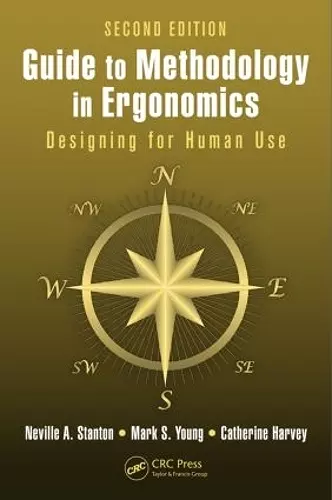Guide to Methodology in Ergonomics
Designing for Human Use, Second Edition
Mark S Young author Neville A Stanton author Catherine Harvey author
Format:Paperback
Publisher:Taylor & Francis Inc
Published:23rd Jun '14
Currently unavailable, and unfortunately no date known when it will be back
This paperback is available in another edition too:
- Hardback£195.00(9781138434721)

Packed with illustrations and practical examples, Guide to Methodology in Ergonomics: Designing for Human Use, Second Edition provides a concise introduction to ergonomics methods in a straightforward manner that helps you conduct an ergonomics analysis of a product in development. It details the execution of 12 ergonomics methods that can be applied to the design of any type of product or interface. The authors stress the role of ergonomics in reducing device interaction time and user error while improving user satisfaction and device usability.
See What’s in the New Edition:
- Four case studies
- Addition of another co-author
- Examples that reflect current technology
- Information on Critical Path Analysis (CPA)
The authors highlight where ergonomics methods fit in the design process and how to select a method appropriate for your purpose. They describe each method, supplying an overview, instructions on how to carry out an analysis, a mini bibliography, pros and cons, one or more examples, and a flow chart. They then rate each method for reliability/validity, resources, usability, and efficacy. The book then examines data from studies on training, reliability, and validity, and presents an equation that enables you to calculate approximately the financial benefits of using each method.
Based on research and expertise, the book gives you the freedom to be adventurous when choosing methods and the foundation to choose the method that fits the task at hand. Written by experts, it also helps you hone your skills and put the craft of ergonomics into practice.
"This book provides an updated guide to several ergonomics methods for analyzing tasks and cognitive performance at work. The methods are described in readily understandable language and illustrated with practical examples. This book will be a valuable addition to the arsenal of the ergonomics practitioner."
—Alan Hedge is a Professor in the Department of Design and Environmental Analysis, Cornell University and a Research Professor in the Department of Mechanical and Aerospace Engineering at Syracuse University
"Stanton, Young, and Harvey have performed a signal service to the profession of ergonomics by bringing together in one place a lexicon of methods which permit the practitioner to enact their craft. Carefully selected from an even wider landscape of investigative techniques, these individual methods are highlighted, explicated, and integrated for those who look to operate in the real-world. The text then is a vital resource to all those who look to affect design, production, maintenance, and sustainability in ever more complex and resilient operational systems. Evolving from and updated with respect to an already classic resource, the present text provides convenient and relevant solutions to problems posed in all realms of human-technology interaction. Destined to take its place alongside other multi-edition classics, the present work is not merely about ergonomic tools but is a vital ergonomics tool in and of itself. This book should be in the locker of all those who practice ergonomics. Their investment in it will be repaid manifold, a modern and evolving classic of our times and of our profession."
—Peter Hancock, University of Central Florida
"Ergonomists need not only to understand various methods for evaluating and improving the design of artificial products, environments, and systems, but also to have the ability to choose the best method according to the purpose and situation. This book reviews 12 practical ergonomic methods for evaluating and improving the design of devices and interfaces. The main point of the book is to interpret the advantages and disadvantages of each method in detail from the ergonomic and financial perspectives. Interestingly, this book rates each method according to four perspectives: reliability/validity, resources, usability, and efficacy. [This helps] readers to choose the best method for the design on which they are working."
—Satoshi Muraki, Faculty of Design, Kyushu University, Japan
ISBN: 9781466591851
Dimensions: unknown
Weight: 249g
140 pages
2nd edition